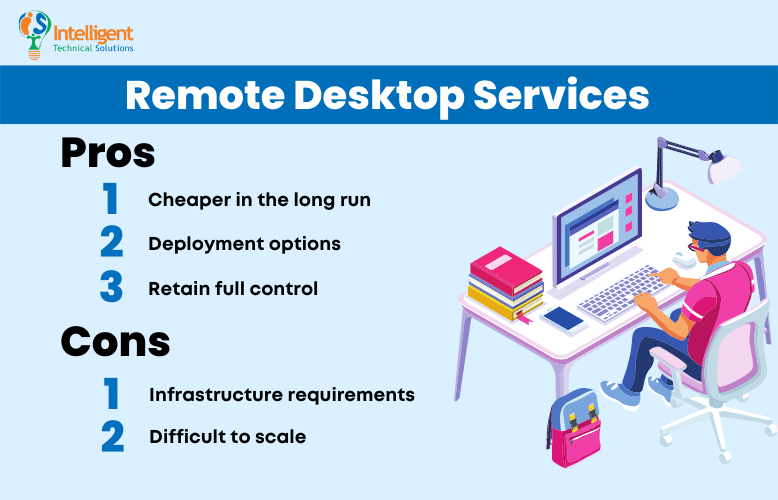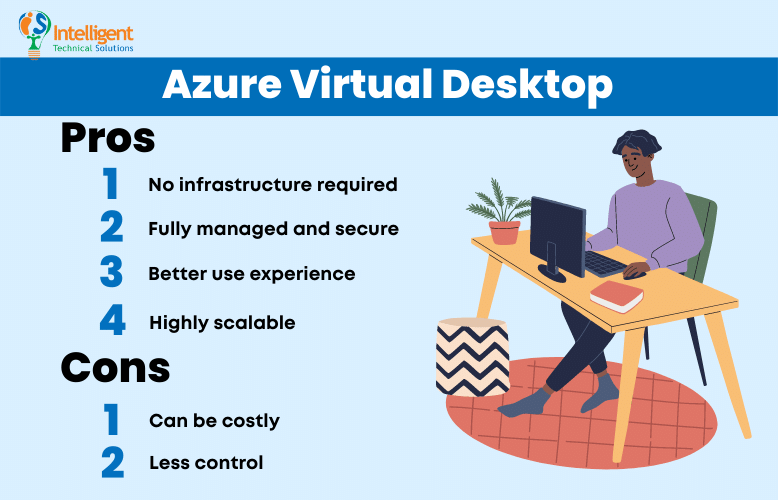What is the Best Way to Access Your Network Remotely: AVD or RDS?
July 18th, 2022 | 5 min. read

Since the pandemic hit, many companies have decided to forgo leasing office spaces to have everyone sign in from wherever they are. If you're reading this right now, you might be considering that as a viable option yourself. But hold that thought.
There are a lot of things you need to prepare for before giving up on that office space. Key among them is how your team will access your network remotely. Remote work brings up a lot of security concerns. Allowing people to waltz into your network and access your systems and sensitive data should be a critical consideration.
There are a few ways of allowing remote access, all of which come with varying levels of risk and security. Choosing which one best suits your business could help you take full advantage of a flexible and secure remote work setup.
At ITS, we help businesses like yours weigh their options by providing useful insights on various tech solutions. In this article, we'll go through the most common methods used to access networks remotely, Azure Virtual Desktop (AVD) and Remote Desktop Services (RDS). We'll dive into each one's pros and cons so you can better understand which one will work better for your organization.
What is Remote Desktop Services?
Remote Desktop Services (RDS) is a secure network communications system developed by Microsoft. It's a set of features that allows users to connect to the server and access a full Windows desktop that's actually running on the server itself. In short, it enables your team to get on their work computers from anywhere.

When used properly, it can be a quick and cost-efficient way to implement a remote-work setup. However, there are some things to consider when using RDS. Check out the pros and cons of using it for your office environment:
Pros of Remote Desktop Services:
Cheaper in the Long Run
RDS requires a large investment from the start. You could spend tens of thousands just to get started. Thankfully, it gets better. Once that initial investment is made, you will start seeing your returns shortly after.
"It can be expensive to do [RDS] on-premises," said Kyle Ramirez, a former ITS Technical Sales Engineer. "Let's say you want to invest in your remote desktop services on-premises. That could be worth $20,000 in hardware at a minimum for one server, and then you have to pay the project teams to set it up with all the services. Then, you have to pay for the data and electricity to run all of these new servers."
Ramirez explained, however, that your cost savings will start accumulating as time goes by. Ultimately, in the five to six years your servers will be operational, the costs will be cheaper than using AVD. "It really depends on how you want to invest your money. Do you want to invest it upfront or pay monthly?"
Deployment Options
While AVD is available exclusively on Azure, you can deploy RDS on-premises or in the cloud. That means you have the option to choose where to store your data—a plus for companies that want to keep sensitive data as private as possible.
Retain Full Control
A Microsoft RDS environment requires a more hands-on approach, but it grants you full control over everything. That means your team will be responsible for managing your hardware and software and optimizing your systems. However, if you don't have the right personnel, this might become more of a bane than a boon.
Cons of Remote Desktop Services:
Infrastructure Requirements
Running RDS on-premises means you will still need a physical location for all your servers. That means you will still have to worry about power consumption, space, security, and maintenance to ensure servers are running properly.
Difficult to Scale
RDS is more difficult to scale (up or down) than AVD. It is often built and licensed to accommodate the maximum number of concurrent users that may need the platform. AVD, on the other hand, is licensed as part of your Microsoft 365 licensing suite. In addition, you are required to purchase separate Client Access Licenses (CALs) for an RDS environment.
What is Azure Virtual Desktop (AVD)?
AVD, previously known as Windows Virtual Desktop, is a modern version of the azure platform-as-a-service-based solution for virtual desktops. Like RDS, it allows your team to access office computers from anywhere. The big difference, however, is that AVD eliminates the hardware management requirement and streamlines the process. That means Microsoft handles data storage, security, management, and maintenance.
The platform offers a less hands-on approach. You can manage it without the cost, complexity, and rigidity of building and running the same service on-premises.

Pros of Azure Virtual Desktop:
No Infrastructure Required
AVD can virtually do away with any hardware management requirement to run remote desktops. You can run it on almost any device and instantly access your Windows environment. A big plus if you're observing Bring Your Own Device (BYOD) policies.
"Instead of purchasing computers and putting them all in one office, you can spin up virtual machines. You can then put them in the Azure Virtual Desktop service, and now users can remote desktop into a virtual machine that's in the Microsoft Data Center," Ramirez explained.
Fully Managed and Secure
With AVD, a lot of the hardware and software management goes on in the background. Your data is tucked away safely in a Microsoft Data Center, and a team of experts manages everything else. It offers a more hands-off approach that can benefit organizations that may want to maximize their team's efforts toward growing the company.
"You're keeping all of your virtual machines that users are accessing in Microsoft's Data Center. They ensure that the hardware is up to date, and they handle any repairs," Ramirez shared.
In addition, AVD includes many security capabilities that can help keep your organization safe. It has many built-in advanced security features, such as Reverse Connect, which can reduce the risk involved with having remote desktops accessible from anywhere. In addition, Microsoft manages portions of the services on your behalf.
Better User Experience
AVD also offers a full Windows experience. In short, it feels like you're working on a desktop and not a virtual machine running on a server.
It also offers native and third-party monitoring capabilities that can help your IT team provide support for your remote employees.
Highly Scalable
Flexibility is one of the main advantages of AVD. It is highly scalable, up or down, depending on your needs. That's a major plus if you frequently work with contractors or third-party suppliers that you want to bring into your environment. You can easily allow them to remote in, then remove their access once the contract is completed.
Cons of Azure Virtual Desktop:
Can be Costly
One of the biggest drawbacks of deploying AVD on your network is the cost. "It's not a cheap solution," Ramirez said. "Primarily, the big shift in cost is from operations expenses to capital expenses. So, instead of investing a lot paying upfront for on-premises hardware, you kind of pay month to month," he added.
According to him, the monthly rates can accumulate over time to the point where setting up your own physical servers might actually cost less money. However, that all depends on what's the best fit for your organization's current needs. As we mentioned above, if you don't have the right people to manage your servers, it might be doing more harm than good to your bottom line.
Less Control
As we mentioned before, AVD is fully managed by Microsoft. That may be a positive for some. However, some want more control over their systems. In those cases, it might be better to go with RDS.
Ready to Choose Between RDS or AVD?
RDS and AVD are both viable solutions for a remote work setup. But each has its own pros and cons. RDS is cheaper but requires more investment upfront, and it offers more control but is less flexible regarding scalability. On the other hand, AVD is a more expensive solution over time but offers excellent value, user experience, and scalability. Choosing the right one will depend on what you need and your team's capability.
At ITS, we've helped hundreds of businesses understand the difference between various tech solutions and guided them to the one that best fits their needs.
Taking the plunge on remote work? Find out how you can make remote work – work. Check out our ebook entitled: Top Tips to Make Remote Work Effective for Your Business.
Mark Sheldon Villanueva has over a decade of experience creating engaging content for companies based in Asia, Australia and North America. He has produced all manner of creative content for small local businesses and large multinational corporations that span a wide variety of industries. Mark also used to work as a content team leader for an award-winning digital marketing agency based in Singapore.
Topics:
